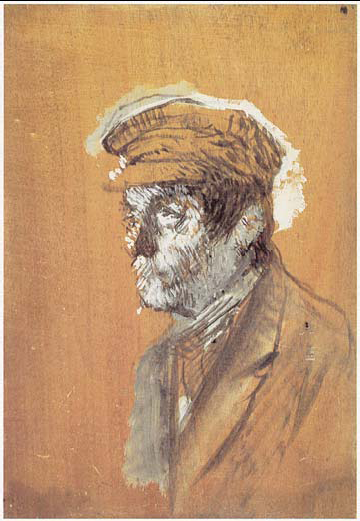Exhibition: Toulouse-Lautrec and the Pleasures of the Belle Époque
Date: February, 8 – May, 6 , 2018
Venue: Canal de Isabel II Foundation , Madrid.

Frustrated and unsuccessful, an artist laments in an illustration in the German satirical magazine Simplicissimus issued in 1910: “You know, if one were a Frenchman, or dead, or a pervert – best of all, a dead French pervert – it might be possible to enjoy life!”. He is endeavouring to paint while his domestic life crowds in on him from every direction:children run about screaming, toys lie scattered on the floor, and his wife is hanging up washing on a line stretched across his studio.

The idea that genius and domesticity are incompatible with one another was hardly new, but the artist’s comment shows how quickly the turbulent lives and premature deaths of Henri de Toulouse-Lautrec and Paul Gauguin had entered popular mythology. Lautrec, who died aged thirty-seven in 1901, Gauguin, who died aged fifty-five in 1903, and the Dutch-born but French-by-adoption Vincent van Gogh did more than any others to colour popular ideas about the ‘artist’ in the twentieth century.

Although the notion of the artist as a self-destructive outsider reached its peak at the end of the nineteenth century with Lautrec, Gauguin and van Gogh, its origin can be traced back to the late eighteenth century when political, cultural and economic revolutions transformed the way artists saw themselves and their relations with the world around them. In 1765, under the ancien régime, the pastel artist Maurice Quentin de La Tour depicted himself as an aspiring courtier, with powdered wig, velvet jacket and an ingratiating smile.

Somewhat less pretentiously and dressed a good deal more practically, his contemporary Jean-Baptiste Siméon Chardin also showed himself as a well-adjusted and contented member of society on a lower social rung. Two or three decades later, the smiles and benign expressions no longer appear on the faces of a new generation of young artists including Jacques-Louis David, Henry Fuseli and Joseph Turner. These are young men in complex and even tormented states of mind, whose self-portraits challenge the viewer with their ferocious stares.
A link between the angry young men of Romanticism and the peintres maudits of the late nineteenth century is provided by Gustave Courbet who, in the 1840s and 50s, developed the myth of the artist in a series of self-portraits culminating famous Bonjour M. Courbet.

In this painting, Courbet flouts social conventions with his bohemian appearance and his lordly body language as he greets his wealthy bourgeois patron. Lautrec, too, relished in the role of bohemian outsider, and celebrated it in a series of elaboratelyposed group photographs of himself and his friends in outrageous fancy-dress costumes. Most hilariously, in 1884 he painted a parody of Pierre Puvis de Chavannes’ noble masterpiece The Sacred Grove Cherished by the Arts and Muses in which he shows himself and his drunken friends bursting precipitately into the sacred grove. He emphasises his own grotesque and dwarflike appearance. Seen from behind, he seems to be urinating in front of Puvis’ solemn ladies.
To get a better insight into the life and the work of the Toulouse-Lautrec, continue this exciting adventure by clicking on: Toulouse-Lautrec, Amazon UK , Amazon US , Ebook Gallery , iTunes , Google , Amazon Australia , Amazon Canada , Renaud-Bray , Archambault , Les Libraires , Amazon Germany , Ceebo (Media Control), Ciando , Tolino Media , Open Publishing , Thalia , Weltbild , eBook.de , Hugendubel.de , Barnes&Noble , Baker and Taylor , Amazon Italy , Amazon Japan , Amazon China , Amazon India , Amazon Mexico , Amazon Spain , Amabook , Odilo , Casa del libro , 24symbols , Arnoia , Nubico , Overdrive , Amazon France , numilog , youboox , Decitre , Chapitre , Fnac France , Fnac Switzerland , ibrairiecharlemagne.com , Bookeen , Cyberlibris , Kobo , Scribd , Douban , Dangdang
By Category
Recent News
- 04/03/2018 - Alles, was du dir vorstellen kannst, ist real
- 04/03/2018 - Tout ce qui peut être imaginé est réel
- 04/03/2018 - Everything you can imagine is real
- 04/02/2018 - Als deutsche Soldaten in mein Atelier kamen und mir meine Bilder von Guernica ansahen, fragten sie: ‘Hast du das gemacht?’. Und ich würde sagen: ‘Nein, hast du’.
- 04/02/2018 - Quand les soldats allemands venaient dans mon studio et regardaient mes photos de Guernica, ils me demandaient: ‘As-tu fait ça?’. Et je dirais: “Non, vous l’avez fait.”